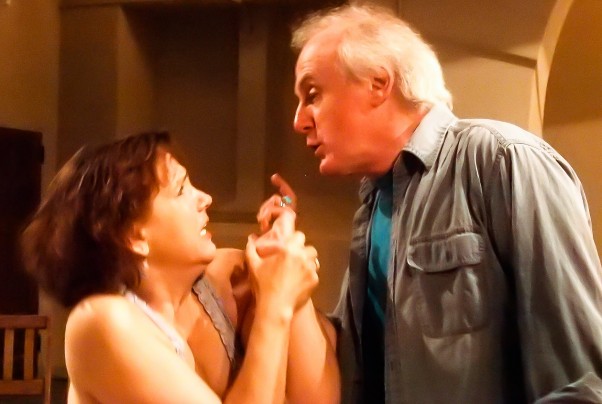 In the early 1970s, Tennessee Williams’ best work was decades behind him. “A Streetcar Named Desire,” “The Glass Menagerie” )now in yet another acclaimed revival on Broadway) and “Cat on a Hot Tin Roof” were part of close-ended theatrical canon of a different era.
In the early 1970s, Tennessee Williams’ best work was decades behind him. “A Streetcar Named Desire,” “The Glass Menagerie” )now in yet another acclaimed revival on Broadway) and “Cat on a Hot Tin Roof” were part of close-ended theatrical canon of a different era.
So when it came time in 1975 for him to open “The Two -Character Play” in New York, after 10 years work, it could only open the second floor ballroom of a tawdry hotel off Times Square.
He died eight years later and the work has only been produced scant times since then (though a New York run with Amanda Plummer and Brad Dourif just ended last week).
Because D.C.’s Spooky Action Theater is adventuresome and brave, it has jumped into the unusual work, which deserves another look especially in light of the continued embrace of his earlier work.
“The Two-Character Play” is the name of a play within a play, in which a brother and sister remain tormented by mental health and institutionalization so damaging that “confinement” is the word they won’t say. Their parents are dead of a murder-suicide which prevents them from cashing in on insurance or paying local bills; they’re trying to reshape the events in their head so they can try to convince the local grocer that a payoff is on the way. They can scarcely step out of their house because of advanced agoraphobia. Connections to the outside world have been severed. Their ramshackle house is surrounded by sunflowers, perhaps reflecting the fantasy in which they live, and there is a gun – the one that did the damage, recently found, as with the bullets.
It all could have made a fine little one act play for late-period Williams, and yet he apparently didn’t have the faith in it to let it stand alone; so he surrounds it with another brother sister acting team that has come to this town to perform the work, though they clearly have their own problems with reality and rage. In this way, he also gets to clearly show his own late period state of mind: fraught with fear, of which he talks quite a bit, and the confines of the theater that has literally locked him in; and the paradox of getting further into a play to free oneself.
This surrounding scenario, cluttered with backstage props and a strange statue, is also titled “The Two-Character Play” and it hangs on through the faith of its director Richard Henrich, artistic director of the company who revived it, and especially in the all-in performances of the two actors who breathe life into it.
Lee Mikeska Gardner and David Bryan Jackson are not brother and sister but a step closer, an ex-couple. In that, they’re like Michael C. Hall and Jennifer Carpener, who played brother and sister on “Dexter,” and got married and divorced in the middle of the run, and kept playing opposite one another as siblings. The layers of connection seem unfathomable.
Gardner and Jackson go one step deeper, tough; they remain connected by being parents of a teenage son. So like siblings, they’re very comfortable with each other on stage and excel in the kind of things that aren’t always on the page: facial reactions, gestures, dirty looks. They’re connected in a way where one actor always knows where the other one is on stage.
They’re both desperate at the edges and frazzled in their long coats, but willing to throw themselves into parts that are only exaggerations of their own status — when they’re not staring out into the abyss, forgetting lines (as their characters in the play within the play do), improvising or trying to get out of the performance altogether.
Once in the play, though, they are at least at first differentiated from their original characters by ladling on some of that Southern drawl so familiar to Williams characters, under somewhat brighter lights.
The perfectly worn and cluttered set by JD Madsen has the further advantage of Spooky Action’s setting, in the basement of the Universalist National Memorial Church, where getting locked in is completely believable.
In a play that balances blowing soap bubbles with handling a revolver, you can see Jackson, by lighting a match and leaving it burn long as possible, burn his fingers twice each performance. Their service to the art, as spoken in the play, is “impossible and necessary.”
“The Two-Character Play” may not have the universal resonance of the smoother and more linear works like “Glass Menagerie.” The problems and contradictions in the script are still all too apparent on stage. But its themes of frailty, mental illnesses, delusion and survival and how they’re reflected in late period Williams should be of interest of anyone interested in theater, and its performances a revelation in themselves.
“The Two-Character Play” continues through Oct. 27 at Spooky Action Theater, 1810 16h St. NW, Washington, D.C.